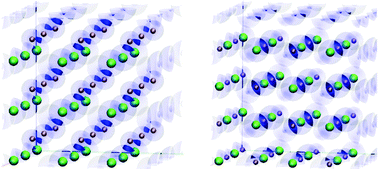Alchemical screening of ionic crystals
Abstract
We introduce alchemical perturbations as a rapid and accurate tool to estimate fundamental structural and energetic properties in pure and mixed ionic crystals. We investigated formation energies, lattice constants, and bulk moduli for all sixteen iso-valence-electron combinations of pure pristine alkali halides involving elements Me ∈ {Na, K, Rb, Cs} and X ∈ {F, Cl, Br, I}. For rock salt, zinc-blende, and cesium chloride symmetry, alchemical Hellmann–Feynman derivatives, evaluated along lattice scans of sixteen reference crystals, have been obtained for coupling to all respective 16 × 15 target crystals. Mean absolute errors (MAEs) are on par with the density functional theory level of accuracy for energies and bulk moduli. The predicted lattice constants are less accurate but reproduce qualitative trends. The reference salt NaCl affords the most accurate alchemical estimates of relative energies (MAE < 40 meV per atom). The best predictions of lattice constants are based on NaF as a reference salt (MAE < 0.5 Å), accounting only for qualitative trends. The best reference salt for the prediction of bulk moduli is CsCl (MAE < 0.4 × 1011 dynes cm−2). The alchemical predictions distinguish competing rock salt and cesium chloride phases in binary and ternary solid mixtures with CsCl. Using pure RbI as a reference salt, they reproduce the reversal of the rock salt/cesium chloride stability trend for binary MeX1−xCsClx as well as for ternary MeX0.5−0.5x(Me′Y)0.5−0.5xCsClx mixtures.


 Please wait while we load your content...
Please wait while we load your content...